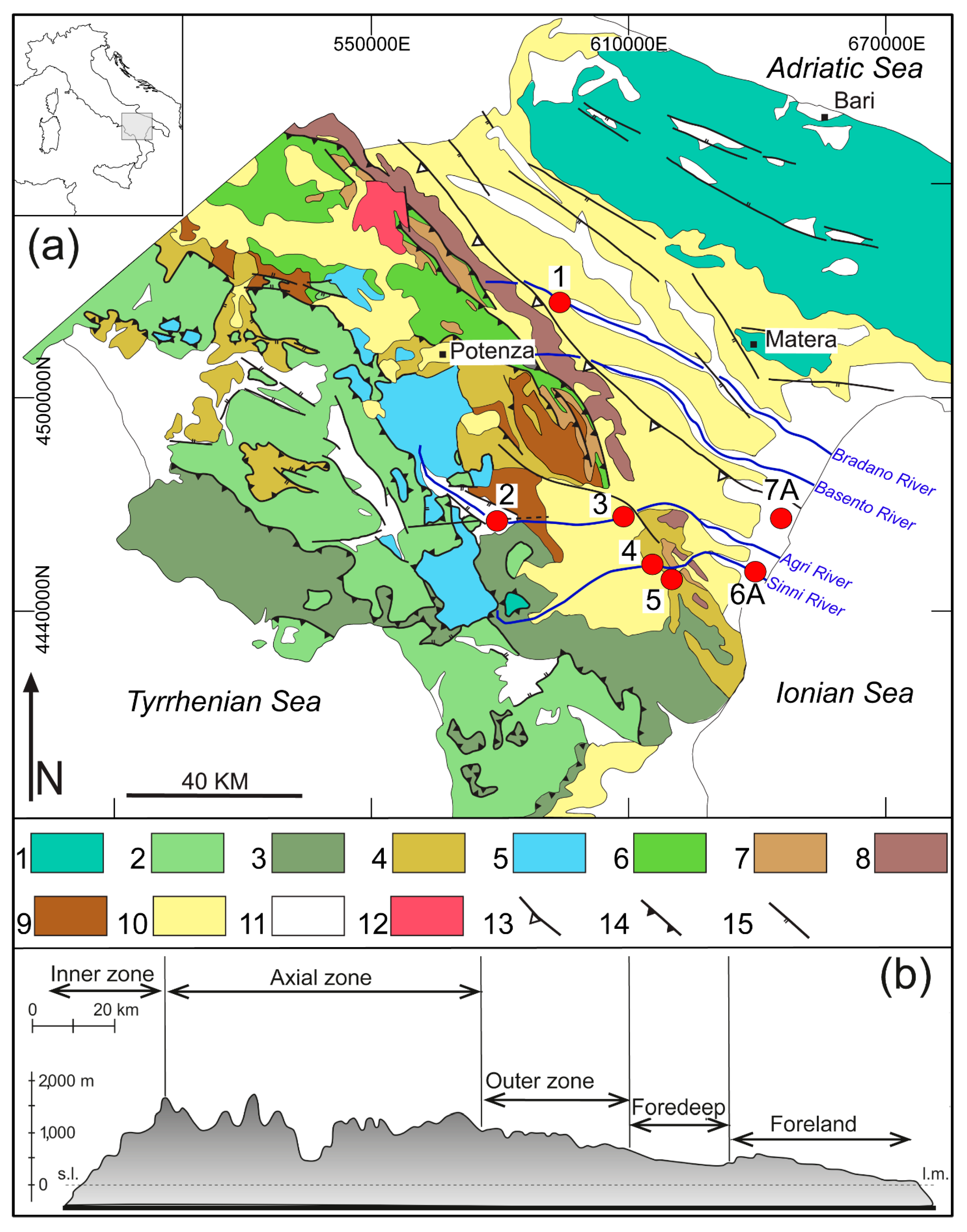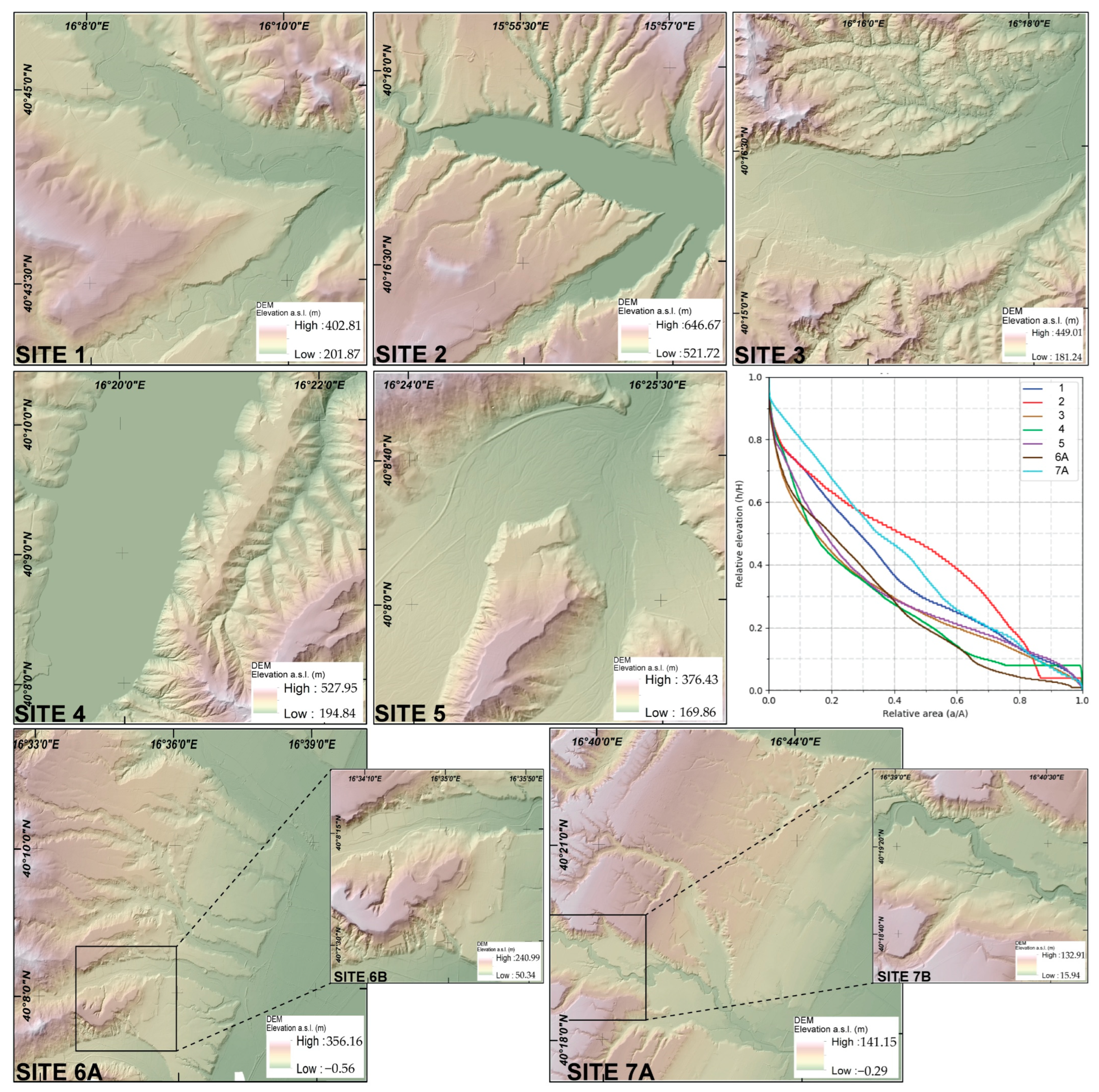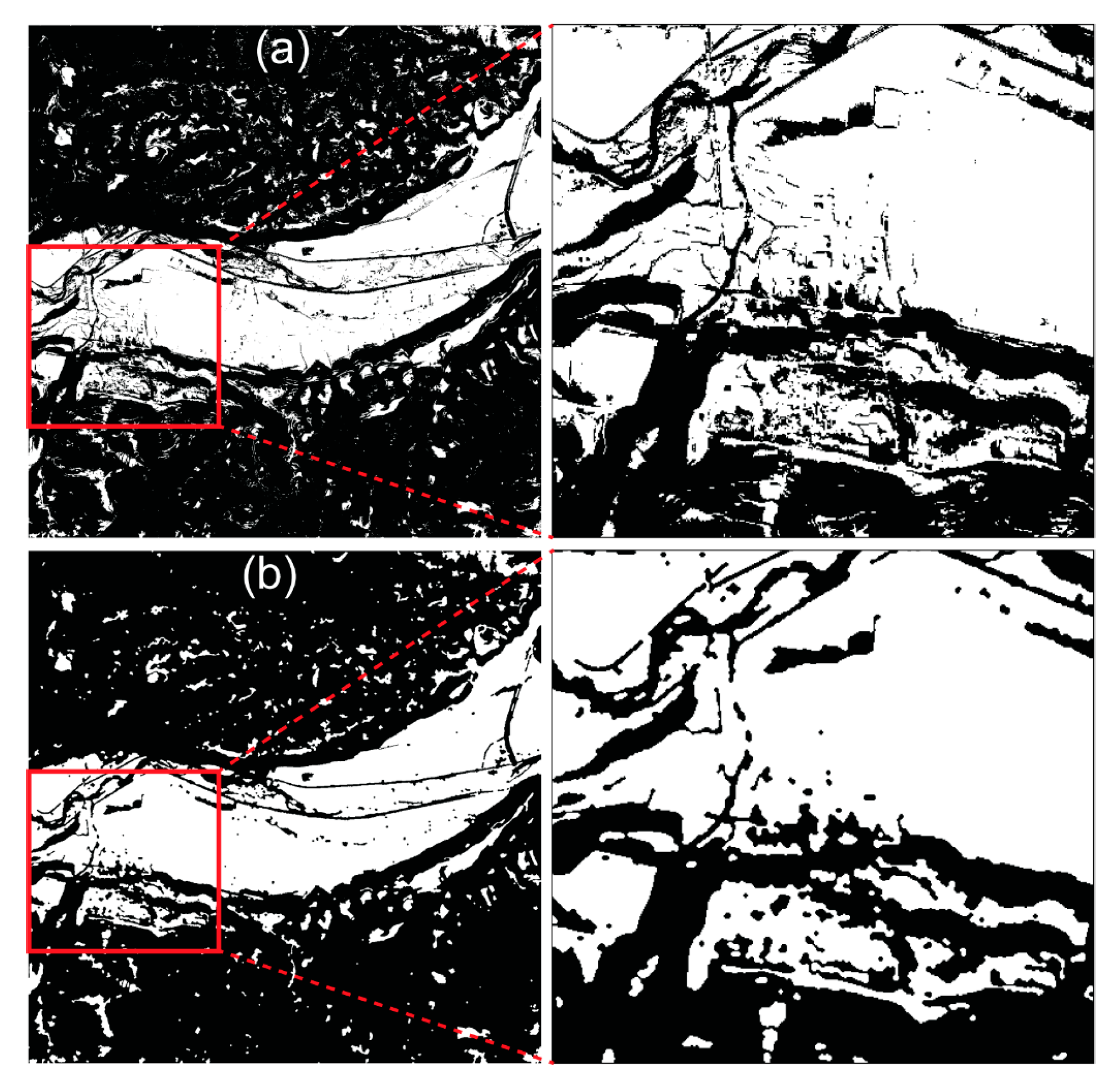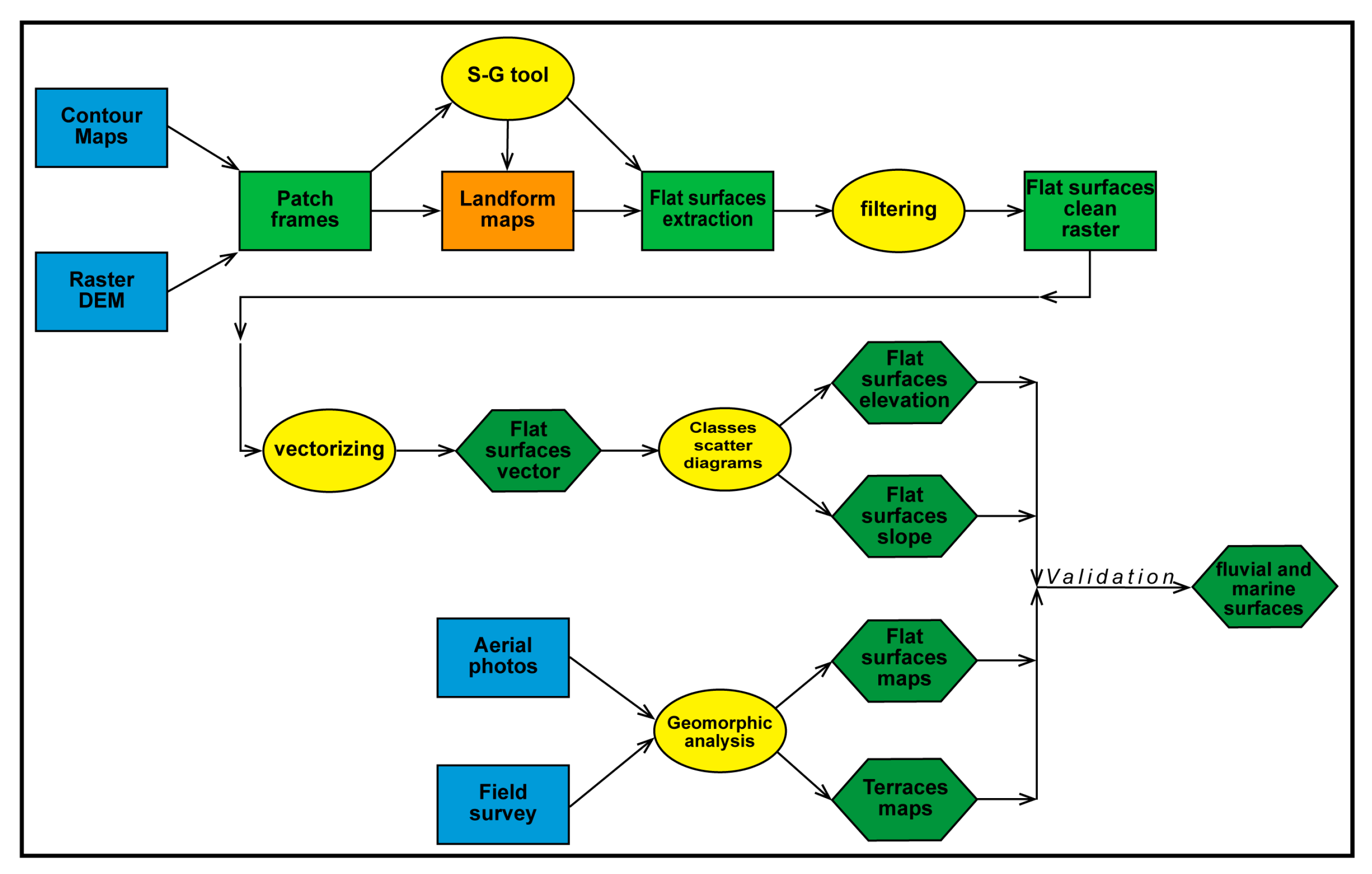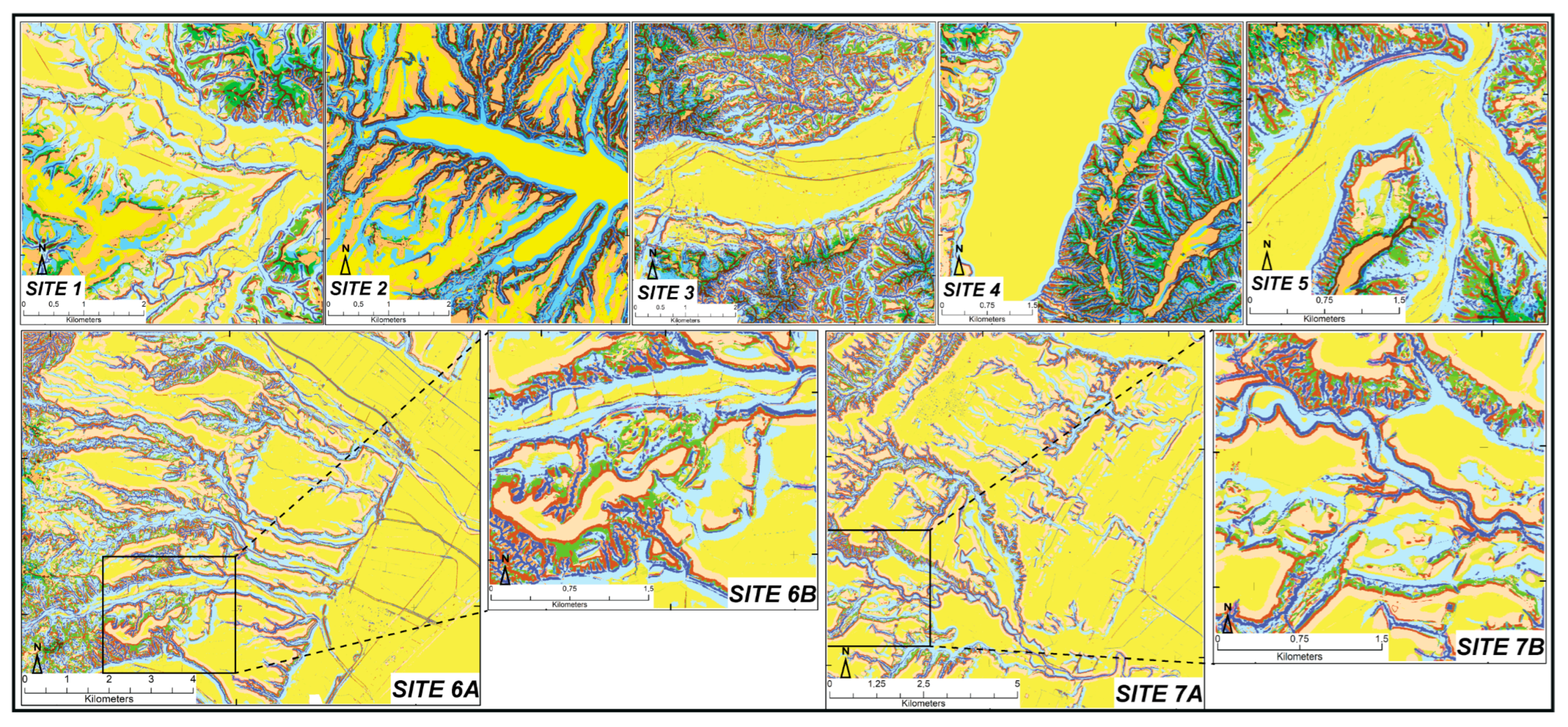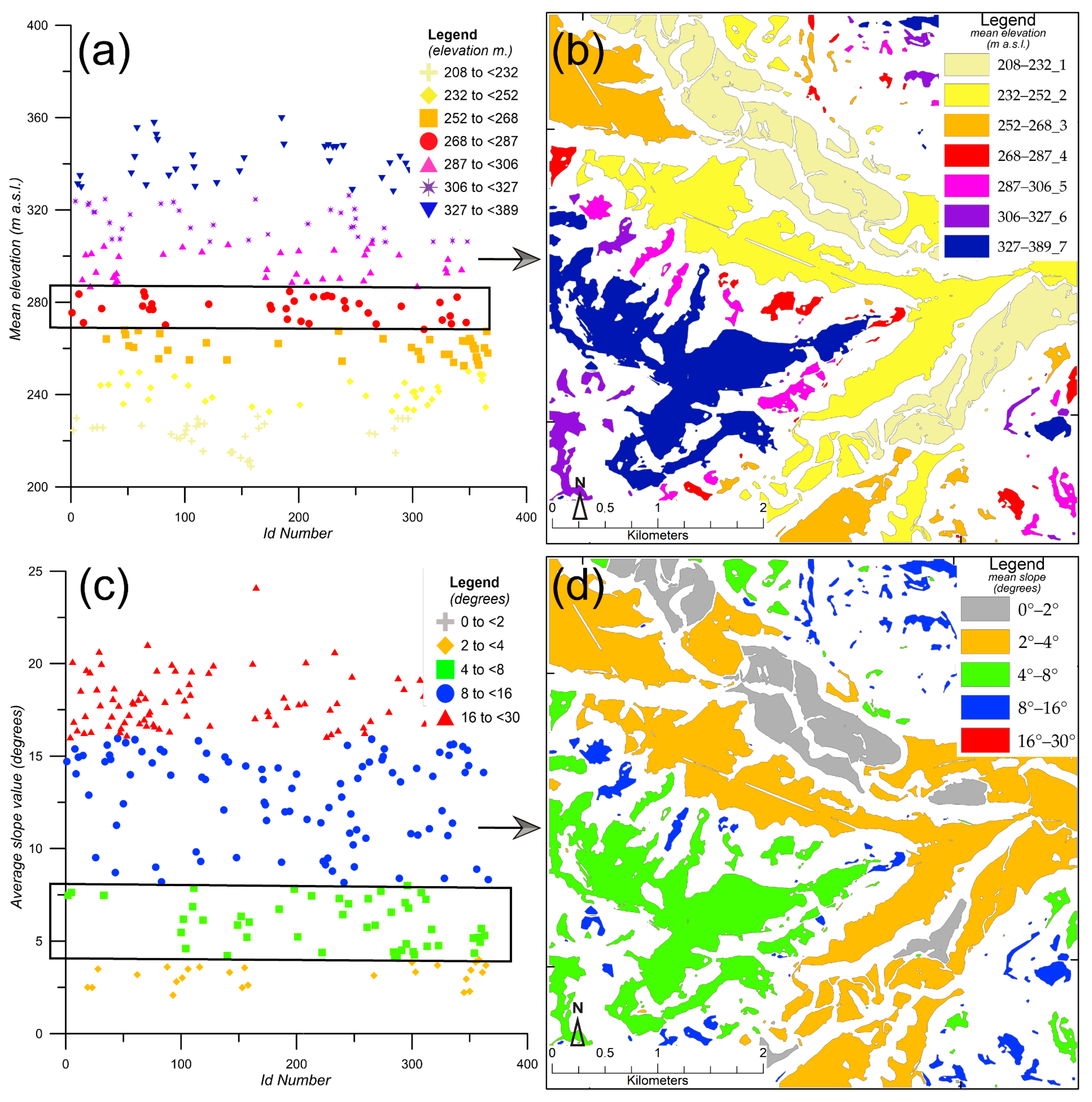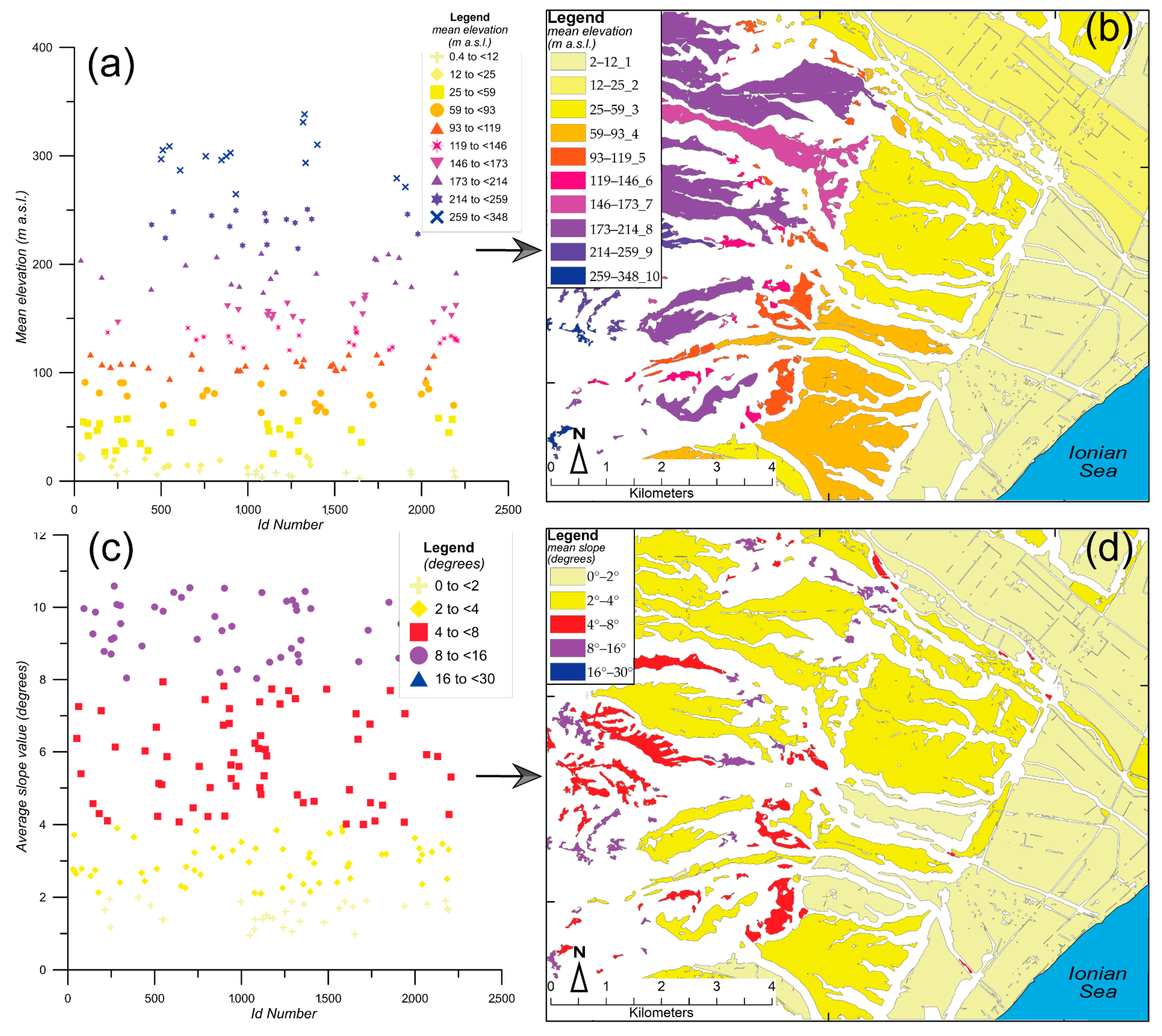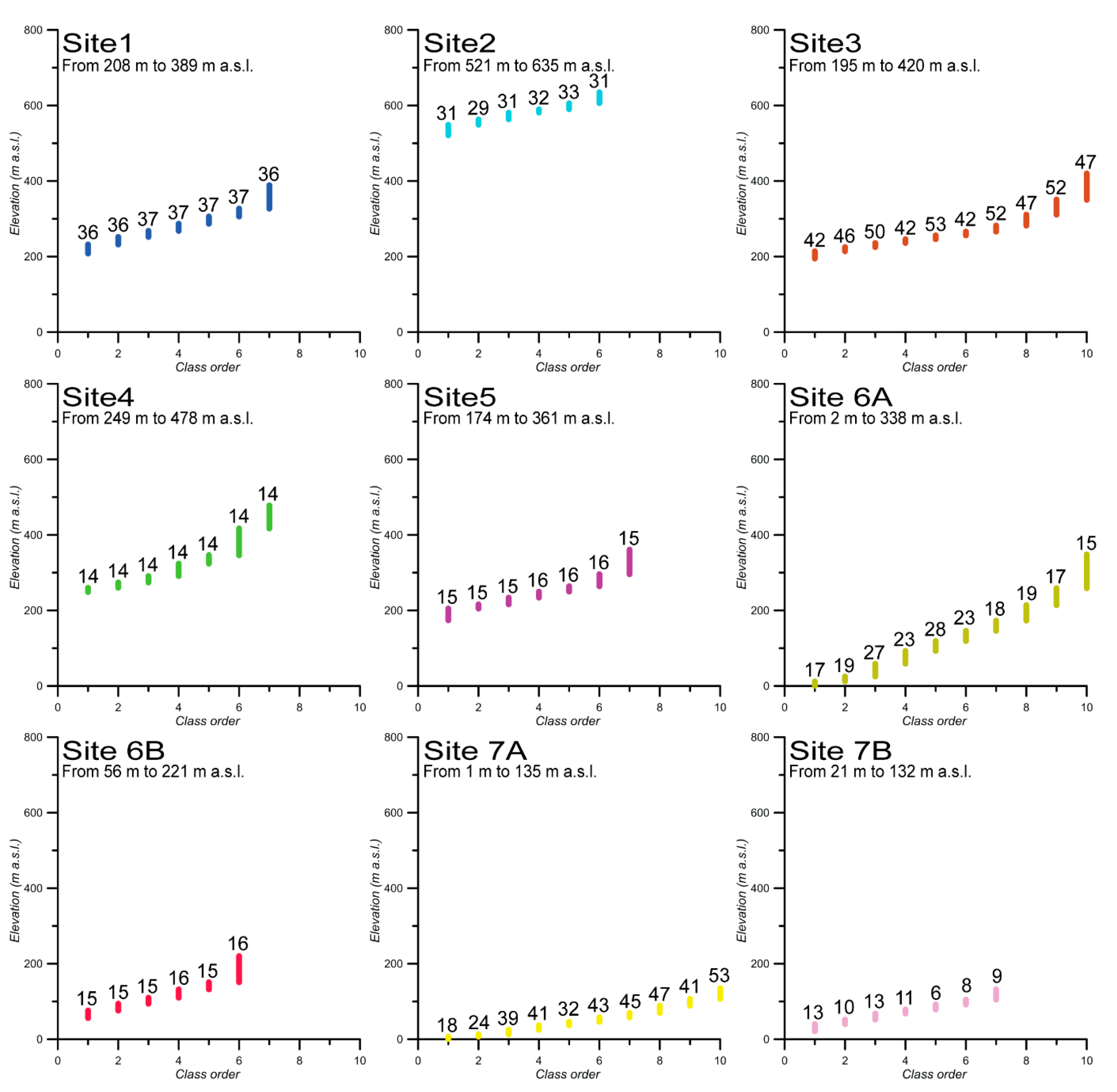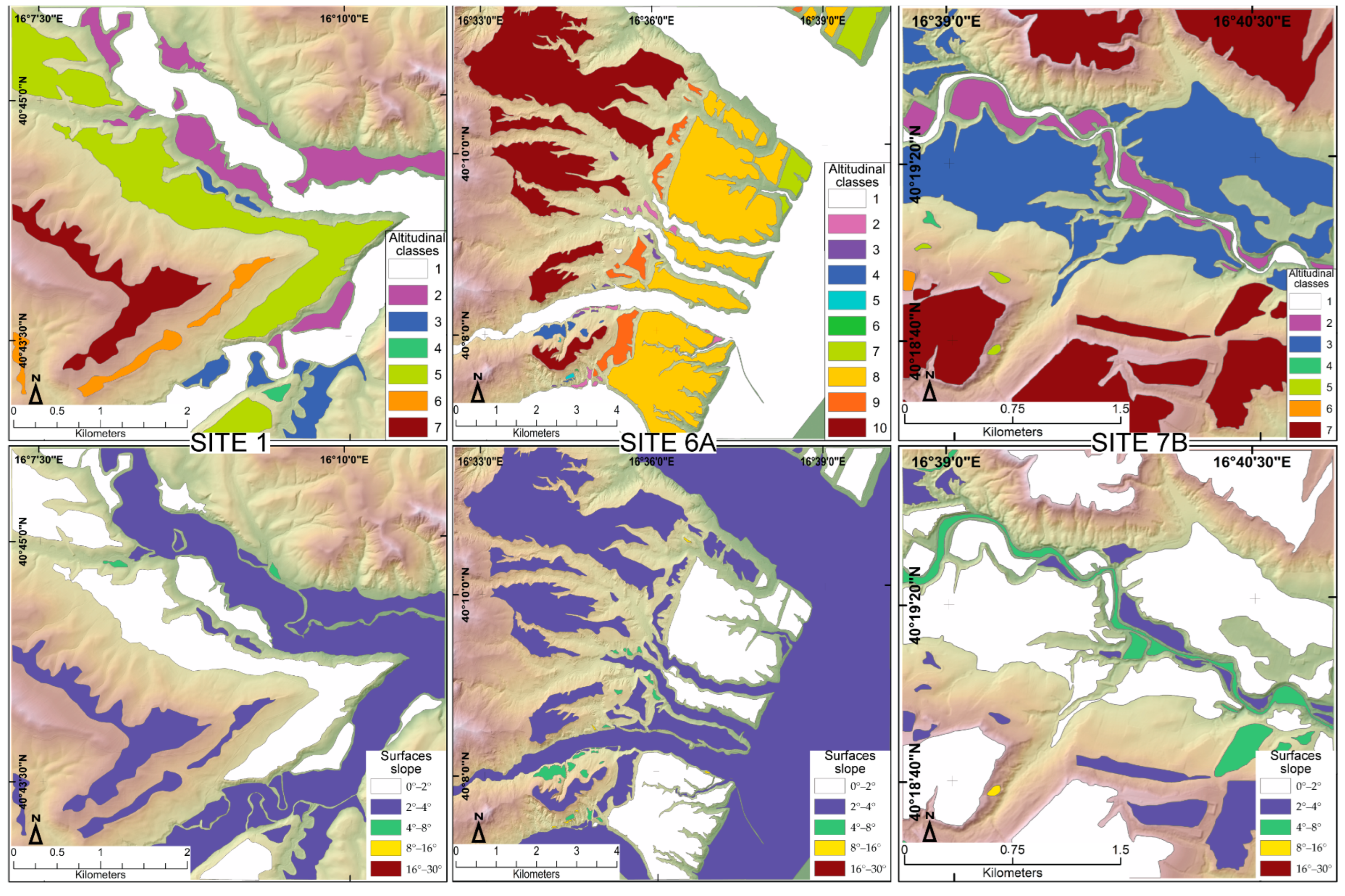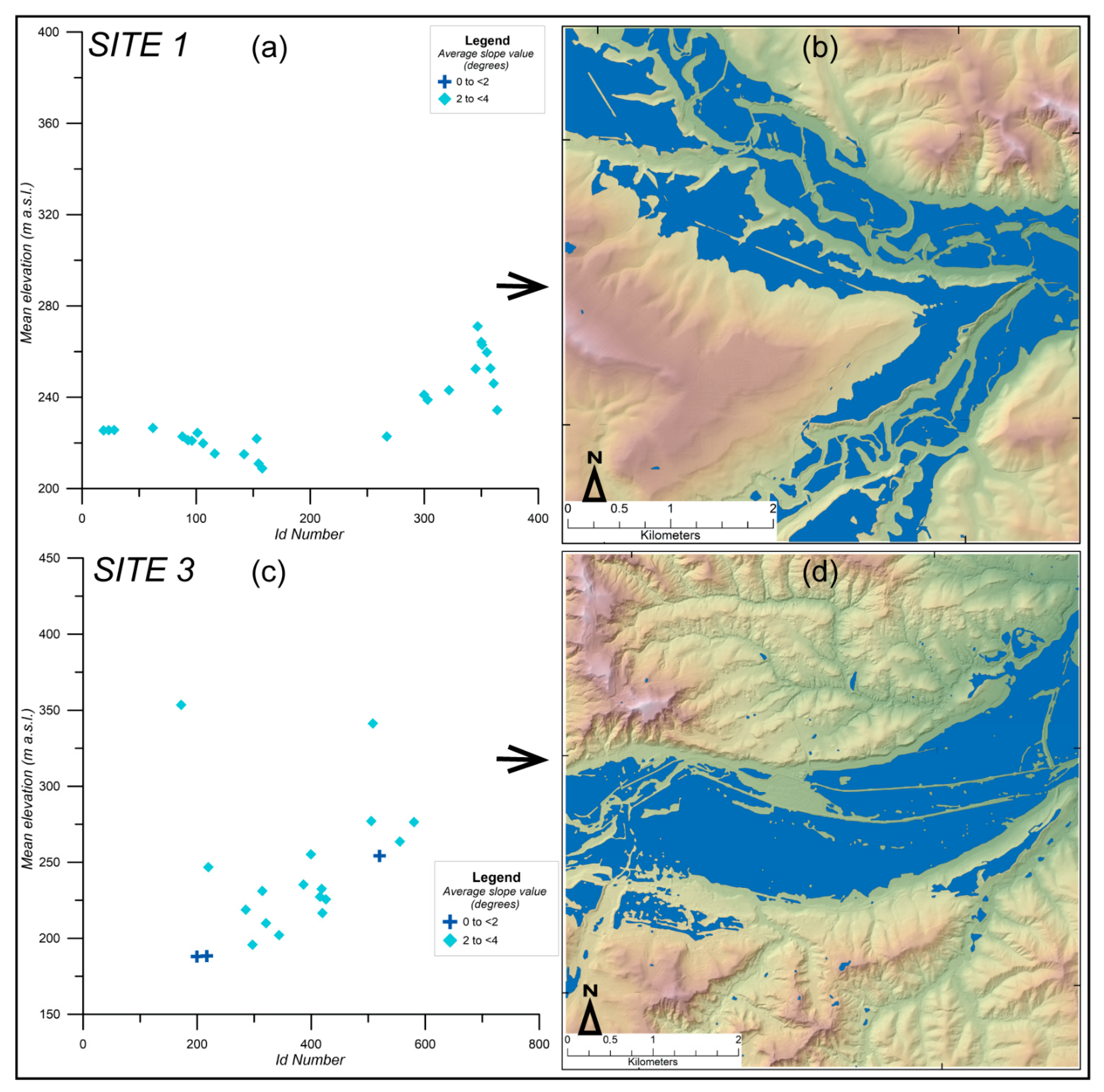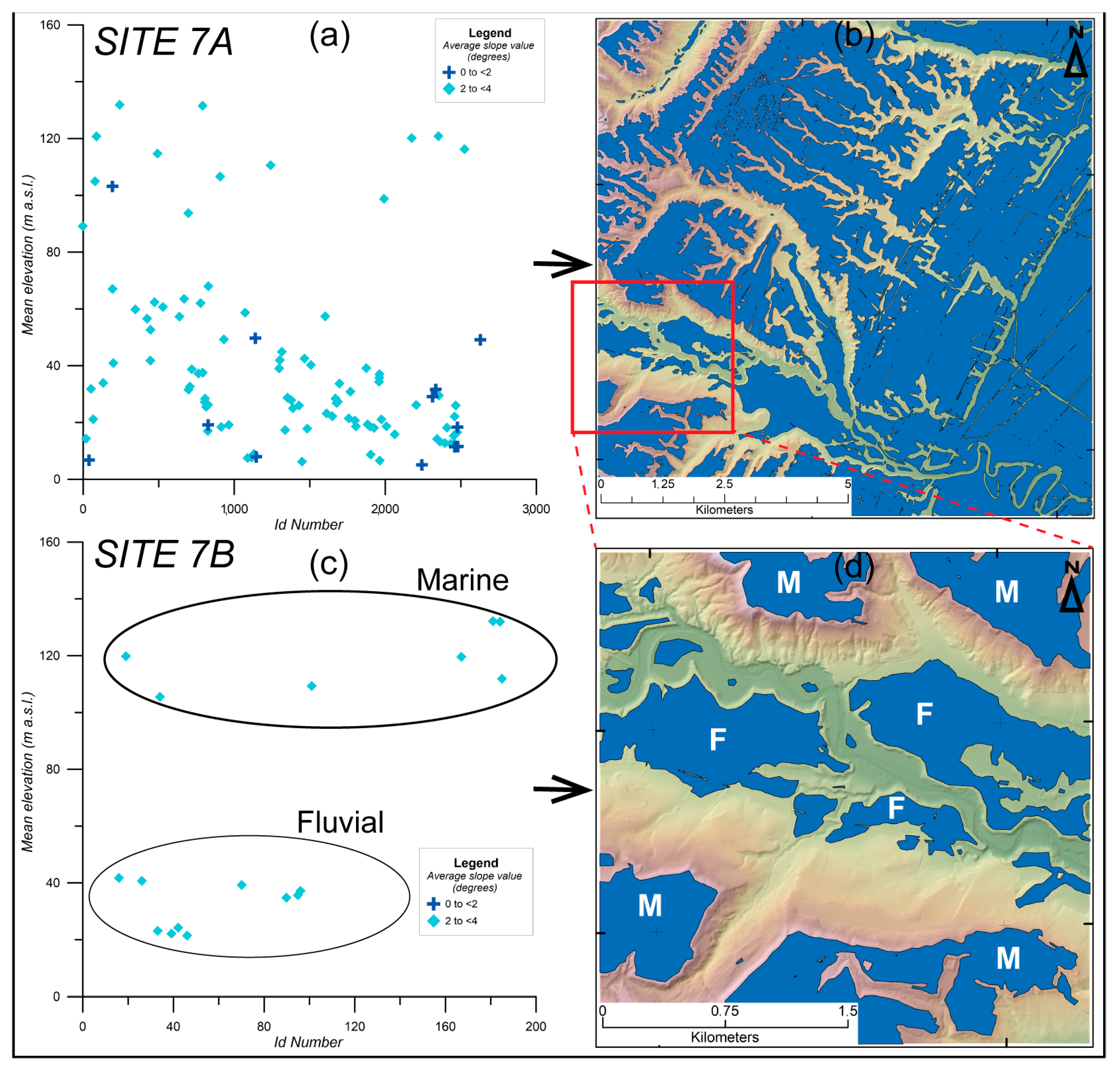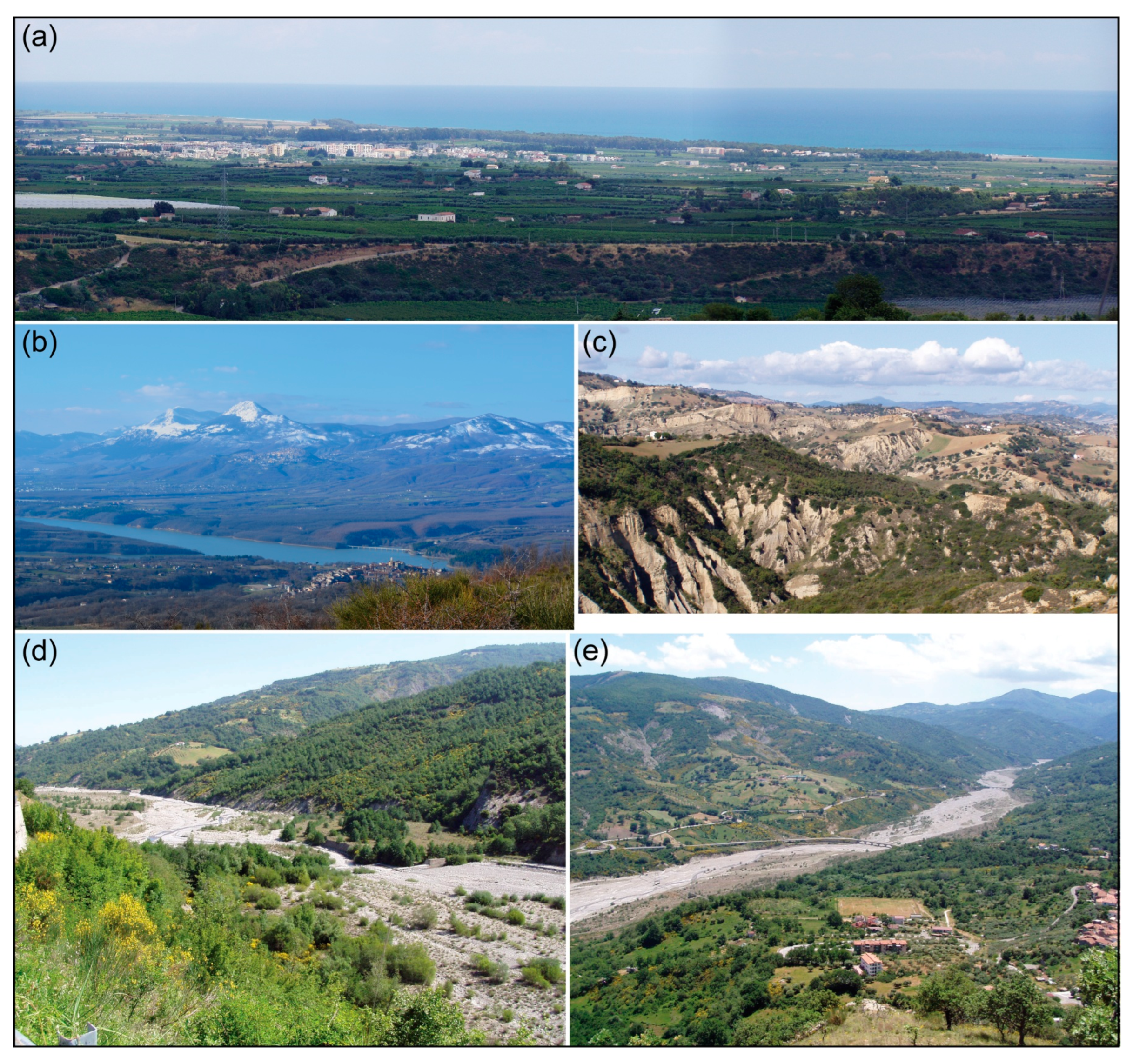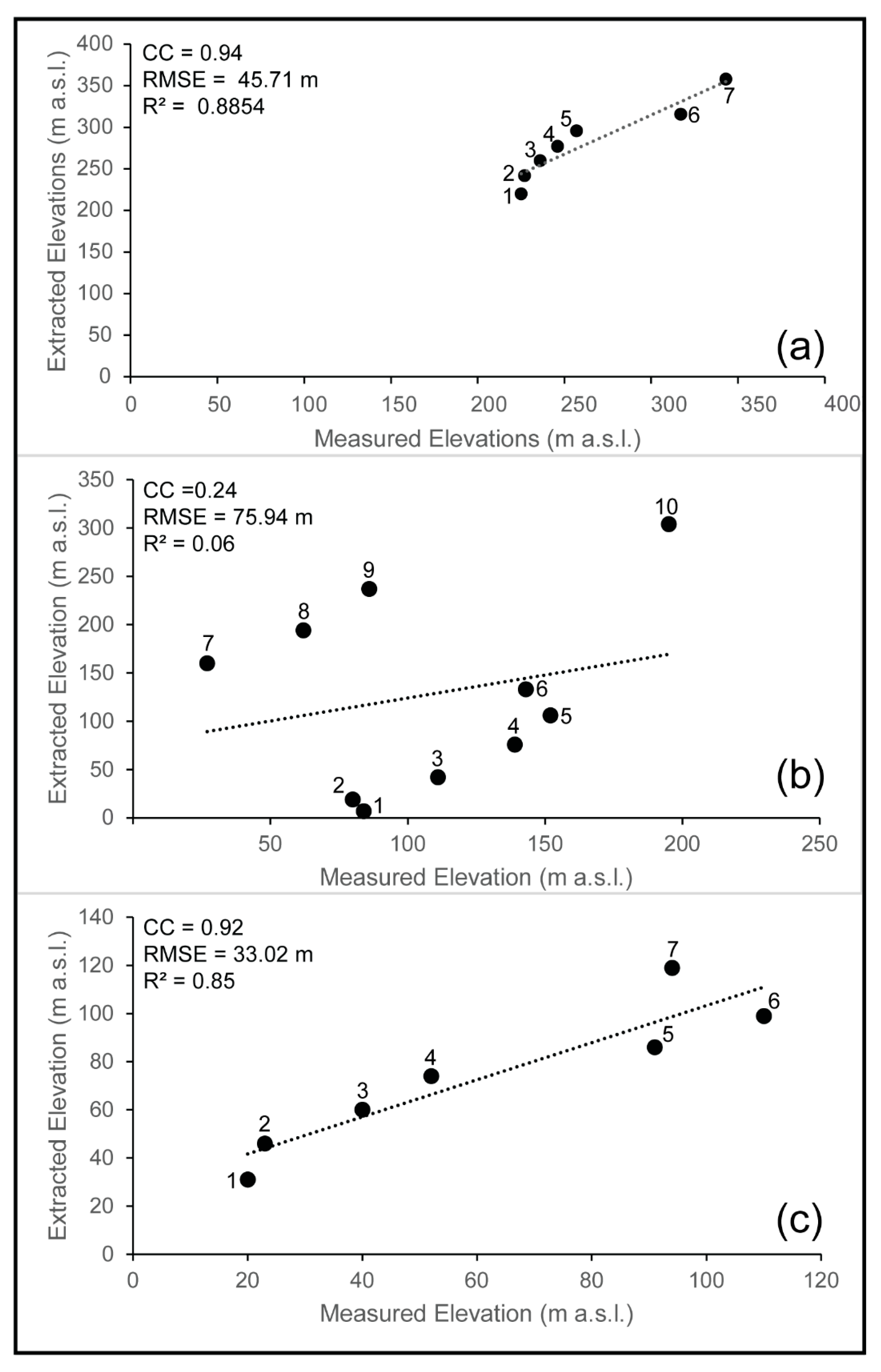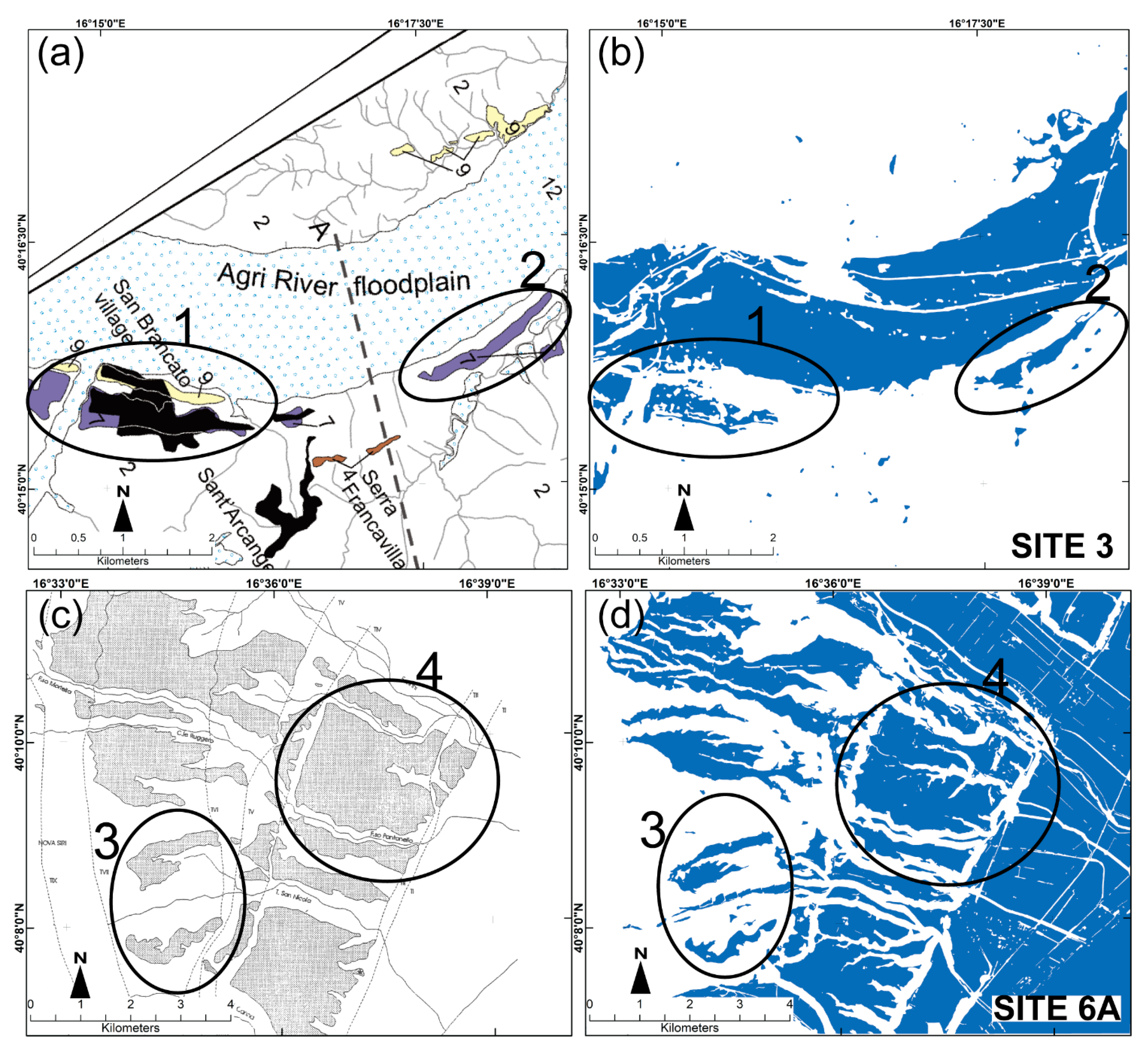1. Introduction
Plain and low-angle landscapes, characterized by small or no differences in topographic elevation, are known in geomorphology as flat surfaces and correspond to depositional and/or erosional top surfaces [
1,
2]. Flat surfaces can be found in several different geomorphic systems, such as glacial, fluvial, aeolian, and marine. A significant distribution of these landforms is found in fluvial and marine landscapes, which are among the common earth’s physical landscapes. Recognizing flat surface landforms provides useful information on a region’s morphological evolution, on an area’s potential hazard, and on a territory’s urban development. Flat surfaces in the fluvial system are represented by floodplains and terraces. The first are flat areas of the alluvial system stretching from the channel stream to the base of the valley walls and over which channel water flows at times of high discharge [
1,
2,
3,
4,
5,
6]. Fluvial terraces are remnants of a former floodplain surface preserved at higher elevation and are underlain by alluvial deposits resting on the flank valley, which occurs in a wide range of climatic and tectonic settings [
5,
6,
7]. Flat surfaces in the marine system are represented by coastal plains and marine terraces. The coastal plain is formed by a plain flat surface and by dune landforms distributed from the beach to inland areas [
2,
8]. Marine terraces are elevated wave-cut benches, marking former high sea levels and produced by the falling of sea levels along a coastline [
1,
2,
9]. In transitional zones, where both alluvial and coastal plains co-exist, the fluvial-mouth landforms merge with the coastal plain ones. Fluvial and marine landforms typically form topographically flat or low-angle slope surfaces distributed over large or small areas. In the past, the flat landform extraction was usually realized by handmade methods, aerial photos, and/or contour maps integrated with field surveys. In the last decades, their recognition was made possible thanks to the availability of topographic datasets provided by digital elevation models (DEMs) [
10,
11]. Many methods have implemented geographical information system (GIS) routines for the automated or semi-automated detection of flat surfaces. Knowledge on process-based surface relationships has allowed many authors to extract specific landform types based on morphological features due to different geological and physical landscapes [
4,
9,
10,
11,
12,
13,
14,
15,
16,
17,
18,
19,
20,
21,
22,
23,
24,
25,
26]. The robustness of results obtained from different DEMs resolution and GIS applications was analyzed using semi-automated extraction and classification of landforms [
27]. Remote mapping approaches based on multi-source and multi-sensor applications were recently implemented in the detection of landforms and processes furnishing multi-scale and multi-temporal modeling in their cartographic representation [
28]. A more complete review of the most recent landforms classification methods was listed in recent papers [
29,
30]. The first authors [
29] analyzed statistical data on the current knowledge of landform classification, identifying more used methodologies, whereas the second authors [
30] addressed the research on the geomorphology-oriented digital terrain analysis.
The objective of this study was to identify and analyze the spatial distribution of flat surface landforms within a complex physical landscape such as that of southern Italy and specifically in large regions where both fluvial and marine flat surfaces are present. This was achieved by integrating a semi-automated GIS extraction and classification method and a geomorphic analysis of landforms. The flat landforms of seven selected areas were extracted using a toolbox in ArcGis 10.7 (
Table 1). To discriminate between fluvial and marine flat surfaces, data gathered from geomorphic analyses and field surveys were employed. The study also categorized the flat landforms within both the fluvial and marine systems into (i) present-day features (such as floodplains and coastal plains) and (ii) ancient ones (including terraced surfaces). Furthermore, the effectiveness of the semi-automated extraction process was validated by comparing the results with mappings from field surveys and previously published research. This comprehensive approach enhances the understanding of landform distribution in this diverse landscape, providing a reliable application for future geomorphological studies.
This study aimed to analyze the spatial distribution of flat surface landforms in southern Italy, focusing on regions with both fluvial and marine flat surfaces. Using a semi-automated GIS extraction method and geomorphic analysis, flat landforms from seven selected areas were identified with ArcGIS 10.7. Additionally, data from field surveys helped distinguish between fluvial and marine surfaces. Flat landforms were categorized into present-day features, like floodplains and coastal plains, and ancient features, such as terraced surfaces. The validation of the extraction process was conducted by comparing results with field data and existing research. This approach enhances the understanding of landform distribution, offering a foundation for future geomorphological studies.
2. Geological and Geomorphological Settings
The current physical landscape of Southern Italy is the result of the Miocene-to-Quaternary geological processes shaping the Southern Apennines chain, the Bradano Foredeep, and the Apulian Foreland [
31]. The chain is formed by east-verging fold-and-thrust tectonic units [
32] overlapped on the Apulian Platform and producing large duplex geometries [
31]. The Southern Apennine chain, from geological and morphological points of view, can be roughly divided into three zones: the inner, axial, and outer (
Figure 1a,b). The average direction of the chain is about N150°, corresponding to the strike of both the main thrusts and the coaxial normal faults, while extensional tectonics is still active along the axis of the chain-deforming Pleistocene sediments. Such a complex structural setting produced mountain chains over 2000 m high and a NW–SE-oriented regional divide. As a result, the drainage network flows towards the Tyrrhenian Sea (southwest), the Adriatic Sea (northeast), and the Ionian Sea (east). The inner zone corresponds to the Tyrrhenian side of the Southern Apennines and includes Cretaceous-to-Miocene, deep-water carbonate and siliceous, pelagic successions overthrusted on Mesozoic shallow-water platform carbonates units [
31]. It corresponds to the Cilento Promontory, with a maximum elevation reached at Cervati Mt. (1900 m a.s.l.). Transverse valleys are cut by rivers flowing toward the Tyrrhenian Sea, locally producing up to 100 m depth of the vertical incision. The axial zone shows high relief with mountain peaks that reach about 2000 m a.s.l. at the Pollino Massif. The geological bedrock in the axial zone is composed by shallow-water carbonate platform units, deep-water siliceous units, siliciclastic arenaceous and clayey units, metamorphic and crystalline units, and clastic successions representing the infill of Pliocene and Pleistocene marine to continental basins [
31]. In the axial portion of the chain, fault-related mountain blocks or morphostructures, bounded by high-angle fault scarps, alternate with tectonically induced basins filled by fluvial to lacustrine deposits, which pit the landscape [
33,
34,
35]. Furthermore, the uplift rate of the block-faulted mountain front was not constant in time and space in the Pleistocene continental intermontane basins [
34]. The outer zone, representing the imbricate frontal thrust units of the chain, is characterized by hilly reliefs not exceeding 1100 m of altitude. It is formed of arenaceous, marl, silty, and clayey deposits. The easternmost zone corresponds to the Bradano Foredeep, mainly filled with Pliocene-to-Pleistocene conglomerate, sand, and clay successions. The foredeep forms a plain area fairly dipping toward the east and transversally incised by a drainage network [
36]. It represents the remnant of a Pleistocene coastal plain uplifted in Quaternary times and vertically incised by streams, as a consequence of the Apennines rise [
37,
38,
39].
The Southern Apennines landscape can be displayed in a SW–NE topographic cross-section, revealing the clear asymmetry of its profile (
Figure 1a,b). The highest mountain peaks are markedly located westwards with regard to the regional watershed line. The asymmetry between the highest mountain peaks and the regional divide was responsible for the greater length and the lower mean gradient in the north-eastern flank of the chain than in the south-western one. The different gradient slope of the topographic profile determines a steeper gradient and shorter length of rivers flowing toward the Tyrrhenian Sea than the rivers of the Adriatic and Ionian seas. The WNW–ESE-elongated rivers flowing toward the Ionian sector are the Bradano, Basento, Agri, Cavone, and Sinni (
Figure 1a). They cross-cut many morphological thresholds, producing a drainage reorganization of the fluvial network [
35,
40] as a consequence of the Pleistocene tectonic uplift of the whole Ionian belt [
37,
39]. High tectonic uplift rates were computed in the axial sector of the chain, which can be attributed to the combined effects of regional uplift and local fault activity [
34]. Remnants of low-angle erosion surfaces, corresponding to palaeosurfaces uplifted and displaced by Quaternary faulting activity and intermontane fault-related continental basins, are the main landforms of the axial zone of the Southern Apennines [
34,
41]. Finally, the main features of the western side are rocky coastal ranges and low coastal plains, which host the main river mouths.
The study area is located in the mid-latitude sector of the Italian peninsula and partly corresponds to the Basilicata Region from a geographical point of view. The physical landscape of the Basilicata Region is composed of different altimetric zones: mountain (46.8%), hill (45.1%), and plain (8%) zones [
42]. The elevation ranges from the Ionian Sea to about 2000 m a.s.l. at the Pollino Ridge and the drainage network is eastward-flowing. Flat surface landforms of different origin and age are found within the seven sampled areas and form a staircase sequence of terraces. Flat landforms corresponding to remnants of erosion surfaces are also found in the investigated areas, corresponding to the highest flat surfaces. They are low-angle-tilted landforms ranging from 6° to 12° or more and were not analyzed in the present work. Site 1 represents the northernmost area of investigation and is the upper reach of the Bradano River Valley (
Figure 2). It was chosen at the confluence of a tributary in the Bradano River showing two connected floodplains and several orders of fluvial terraces. The area was incised within the Pliocene-to-Pleistocene coarse-grained and thin clastic deposits of the Bradano Foredeep [
43]. Site 2 includes the southern sector of the Agri Intermontane Basin, a Pleistocene fault-related trough crossed and incised by the Agri River [
36]. The investigation did not consider as a flat surface the Pietra del Pertusillo Water Lake, which is included in the area. Conversely, much of the flat terraced surfaces were formed by the vertical incision of drainage network into the Middle Pleistocene coarse-grained and thin alluvial deposits filling the valley. Site 3 is located in the middle reach of the Agri River Valley and reveals a large floodplain of the thalweg ~2 km wide. Pleistocene clayey and silty deposits make up the two side valleys, and the high rate of denudational processes was responsible for the creation of a badland landscape with “calanchi” and “biancane” landforms [
38]. Site 4 is located in the middle reach of the Sinni River Valley, where well-developed relicts of fluvial terraces are found [
36]. Site 4 has a large flat surface that corresponds to the Monte Cotugno Water Lake and then was not considered as flat surface. The valley sides are formed of silty-clay deposits with coarse-grained gravel forming the depositional top surface of fluvial terraces. Site 5 displays the lower reach of the Sarmento River Valley, where a tributary flows in the main channel, isolating remnants of high flat surfaces corresponding to old fluvial terraces. The lowest and non-incised flat surface corresponds to the floodplain of the Sarmento River. The site is characterized by the same lithologies of site 4. Both sites 6A and 7A (
Figure 2) are situated close to the Ionian Coastal Plain, which is transversally incised by the Sinni (site 6A) and the Cavone (site 7A) Rivers, respectively. The two sites are larger than the previous ones, reaching about 80 km
2 (site 6A) and 100 km
2 (site 7A), and contain large remnants of Pleistocene marine terraces, strongly incised by the drainage network [
37,
39].
3. Materials and Methods
The study area lies in the Southern Italian Apennines chain, where the physical landscape varies from mountain to hills and coastal zones in a low spatial arrangement. It contains flat and low-angle surface landforms, mainly generated by fluvial, marine, and mass movement processes. In selected sampling areas, two combined parameters were used, the best resolution of available DTM, along with two morphometric parameters, the relief and the hypsometry. Ref. [
27] compared landform extraction using different resolutions of digital terrain models (DTMs): 5 m, 20 m, and 90 m. They found that the most accurate landform extraction was achieved with the 5 m resolution DTM. In contrast, the 30 m and 90 m resolutions resulted in less accurate outcomes, meaning that some landforms were not detected by the tool, which led to less precise extractions. The 5 m resolution DTM is less time-consuming in the elaboration and provides satisfying results in the mapping visualization [
28]. The 5 m resolution DTM of the study area is freely available at
https://rsdi.regione.basilicata.it (accessed on 10 May 2024). We used the digital terrain model (DTM) of the Basilicata Region (IT), which is freely available online from the above-mentioned site. The DTM was realized by using an aerial photogrammetric flight from 2013 and was generated by both the ground and model keypoint routines and by a triangulated model z of interpolation. The obtained 5 m resolution DTM was then exported into the ASCII GRID format. The metadata are in UTF8 format, based on the ISO/IEC 10646 standard. The horizontal accuracy of the DTM is 5 m, and the vertical one is 1 m. The information of the DTM metadata are in accordance with the “LineeGuida RNDT” available at the
https://rsdi.regione.basilicata.it (accessed on 10 May 2024). The spatial reference of the DTM are related to the Datum ETRS89/UTM-zone33N.
The studied area contains flat and low-angle surface landforms, mainly generated by fluvial, marine, and mass movement processes (see
Figure 1a for location areas). Landforms related to mass movement processes were not considered in this study due to the poor outcomes in the semi-automated extraction procedure. Seven small-scale areas were clipped from the DTM, thus producing small patch frames, following the procedure proposed by [
22]. The clipping procedure provides small-shaped sites of investigation and allows users to reduce both the computation and the time-consuming nature of the investigation. Small-shaped sites are not recommended because the information provided by the selected patches are not representative of the landscape and topography, furnishing unsatisfactory performances. Conversely, large-shaped patches produce a fast increase in demand of the memory system, and performance will be too slow, thus consuming time. The selection of patch frames includes areas containing both floor and terraced flat surfaces related to fluvial and coastal landscape systems. The frames numbered from 1 to 7 (
Figure 1) have a spatial distribution ranging from 25 to 100 km
2 width. The two frames 6A and 7A, containing very large areas of approximately 80–100 km
2, were detailed by adding two smaller boxes, 6B and the 7B. The centroid coordinate was used to represent the location of each frame (
Figure 2). In selecting the patch frames, we followed the approach utilized in [
24,
25]. However, we made a distinction by focusing on sampling areas that featured either small or large flat surfaces. Additionally, we aimed to select areas that featured fluvial and/or marine flat surfaces. Furthermore, before the use of the S-G toolbox, the patch frames were preprocessed, filling the “holes” in the raster by using the fill plugin and removing all the small imperfections from the data raster, thus furnishing a new filled surface raster. The next step involved the semi-automated extraction of flat surfaces landforms using GIS application. The clipped and filled DTMs were implemented with the S-G toolbox (version 1.0) [
24] running in the ArcGIS application (version 10.7), and the semi-automated extraction and classification of landforms were carried out. The procedure of landforms extraction was based on the topographic position index (TPI) [
44] implemented in GIS-based applications [
45]. The topographic position index (TPI) is the difference between the elevation value of a cell and the average elevation of the neighborhood around that cell and represents a quantitative relief index. The S-G toolbox (version 1.0) uses six slope classes, starting from the piedmont slope area up to the watershed divide and discriminate landform classes based on the topographic elevation of the physical landscape related to the potential energy of physical processes. This routine process generates a recurrence of landforms combining the altitudinal classes and the six slope angle classes, thus generating the 48 landforms [
24] listed in
Figure 3.
As a result, the application provides a quick and powerful way to classify landscapes into morphological classes of landforms, and a relevant number of landforms were extracted from the mountain, hill, and plain altimetric zones. Note that each physical landscape in the frame contains only some types of landforms and not all the potential 48 landforms that can be extracted from the tool because of the differences in the topography of landscapes. The flat surface landforms were extracted from the original raster map in a new file using the raster calculator. The bounding boxes of
Figure 3 show the extracted raster of flat surfaces. However, the raster contained many cloud noises linked to small joined pixels, so a cleaning of the raster was necessary. The cleaning procedure was performed using the majority filtering tool found in the ArcGIS Spatial Analyst. By replacing the neighboring cells of similar values in a raster grid with the majority of adjacent cells, the small cells representing the cloud noises were deleted. The filtered raster map’s output is clearer than the original one and free of small clouds. An example of the filtering process applied to site 3 is shown in
Figure 4. The difference between the original and uncleaned raster grid (
Figure 4a) and the filtered and cleaned raster grid (
Figure 4b) is evident, and details are shown in the enlarged right-hand boxes. The best-filtered raster grid was obtained after an iterative filtering process until about 30 extractions. Next, the clean raster grid containing the flat landform types was converted into polygonal features. The polygons were smoothed into simple shapes containing a minimum number of the original raster cell edges. The field parameters of the raster dataset were selected to be used as attributes in the feature classes of the shape files, and the converted polygons not forming flat surface landforms were manually deleted.
The spatial information (X, Y, Z, and slope degree values) was extracted from each flat surface in the raster DEM using the 3D analyst toolbox of the ArcGIS application. The mean values of Z-elevation and the slope degree were used as morphometric parameters to create homogeneous elevation groups of flat surfaces. Surface values of altitudinal and slope mean values were separately plotted in a scatter class diagram. The altitudinal range values were obtained from an iterative process selecting the best fit distribution of flat surfaces in the scatter plot diagram. Take into account that the selection of cluster surfaces distribution was made manually and then was user-dependent. In terms of slope classifications, [
45] defined two slope classes: 0° to 5° and 5° to 90°. In contrast, the new S-G toolbox utilized in [
24] categorizes slopes into six classes: 0–5°, 5–12°, 12–30°, 30–60°, 60–75°, and 75–90°. This paper focuses on the first slope class (0–5°) to highlight the presence of flat surfaces. This classification aligns with the standard slope ranges for fluvial and marine environments (0–2°, 2–4°) suggested by several authors [
46,
47] for non-incised sub-horizontal flat surfaces in fluvial systems as well as [
8] for marine systems. Additionally, the next two classes utilized in [
24] (5–12° and 12–30°), considering that 30° is the maximum slope for the flat surfaces in the sampled areas, were further divided into three classes (4–8° and 8–16–30°) to emphasize tilted flat surfaces.
The selected classes take into account the local morphology, which varies from hilly to plain. The two slope classes ranging from 0° to 2° and 2° to 4° were assigned to floodplains and coastal plains landforms. The class ranging from 4° to 8° was associated to the slope edge of floodplains and coastal plains, where fan and glacis landforms are present. The slope classes ranging from 8° to 16° and 16° to 30° were related to erosional/depositional talus surfaces and scarps. Surfaces ranging from 16–30° or >30° were interpreted as tilted surfaces triggered by tectonic or gravitative processes acting in the region [
37,
39] and were not considered. These ranges of slope values were applied in the sampled areas, thus furnishing the slope values distribution of flat and low-angle surfaces. The procedure used in this paper is illustrated in the flow chart of
Figure 5.
The geomorphic analysis was realized by field surveys and aerial photos interpretation at a 1:33.000 scale, as furnished by the Italian Geographer Military Institute (I.G.M.I.). In the manual mapping procedure, no software was used. The flat surfaces were analyzed by users, and their interpretation is based on the users’ knowledge. They furnished handmade maps of flat surface landforms that were firstly redrawn with design software and georeferenced and then compared with the automatically extracted flat landforms in the validation process. Furthermore, relief and hypsometry parameters furnished information on the potential energy, lithology, and stage of evolution processes [
48]. Local physical landscapes with a mean relief of about 230 m and no abrupt change in the hypsometric curve were considered, suggesting physical landscapes in steady-state conditions [
48,
49,
50,
51,
52]. The altitudinal distribution of terraced flat surfaces was realized by a visual-based mapping, which takes into account the altimetry and the physical correlations of surfaces. Geomorphic analyses were also used in the attribution of flat surface polygons to fluvial and marine systems. The plan-view perimeter of flat surfaces was detected by analyzing the morphological alignment of landform edges and the changes in slope angle between the terrace tread and the adjacent hillslopes. Comparing the azimuthal line orientation of the frontal scarp terraced surfaces and the azimuthal line orientation of both the coastal line and the main river channels, a morphological attribution to marine or fluvial flat surfaces was firstly carried out. In addition, a field survey random check of the depositional facies of flat surfaces was realized in the field, confirming or not the previous morphological attribution. The automatically extracted flat surfaces elevation and slope maps were then validated through the comparisons of two visual-based maps. The first validation was made by overlapping the extracted flat surface polygons and the handmade flat surface maps produced by field surveys and aerial photos interpretation at a 1:33.000 scale. The second validation took into account the past authorship landform maps, which were overlapped on the automatically extracted landform maps. In addition, the accuracy of the results was verified by assessing three statistical parameters: the correlation coefficient (CC), the root-mean-square error (RMSE), and the coefficient of determination (R
2).
5. Discussion
The use of GIS-based analyses and geomorphic assessments has revealed various landform types in the analyzed Southern Italian landscape. The morphological features of these flat landforms have allowed for their classification into distinct categories of these flat landforms and facilitated their classification into distinct categories. Lower and non-incised flat surfaces were assumed to be floodplains of fluvial systems and coastal plains of marine environments. Flat surfaces showing vertical incisions and terracing were classified as fluvial or marine terraces. This systematic method of classifying landforms enhances our understanding of the geomorphological processes and dynamics that have shaped these areas, providing valuable insights into their environmental history. The morphological attribution of terraced surfaces to fluvial systems was carried out taking into account the following: (i) the scarp edge alignment of terraces parallel to the fluvial talweg, (ii) the flat surfaces that are 20 m higher than the local base levels of thalwegs, and (iii) the physical correlation of terraces along the two sides of the valley. The attribution requires caution and careful control of the altitudinal distribution of terraces using field surveys and aerial photogrammetric analyses. The attribution of terraced surfaces to the marine system are mainly related to the morphological features and the presence of marine depositional facies.
The Sinni Coastal Plain area (site 6A) experienced raising due to the interaction between tectonic uplift and climatic changes during Pleistocene times. Hence, actually, the marine terraces were suspended at different elevations a.s.l. The present-day coastal plain area is bounded inland by small-sized rectilinear scarps representing the inner edges of marine terraces. The scarps are NE–SW-oriented and nearly parallel to the Ionian coastal line, supporting the evidence of their marine morphogenesis (
Figure 7). It is worth noting that the orientation of both the fluvial and marine scarp edges serves as the key morphological marker to distinguish between fluvial and marine terraced surfaces. Scarp edges of fluvial terraces are differently oriented according to the elongation of channel rivers. The number of elevation classes of terraces measured in the field and by aerial photos varies between 6 and 10 (
Figure 6), and the same number of classes was found in the semi-automated extraction of flat surfaces. In the Bradano and Agri Fluvial Valleys (sites 1 and 3, respectively), the semi-automated flat terraced surfaces corresponding to low altitudinal classes of terraces are shown (
Figure 12). Terraced surfaces with low slope angles less than 4° are still connected to the present-day floodplains. In addition, the polygons are elongated parallel to the main fluvial valley sides, and the scarps edges are aligned with the main channel line. Right-side terraced surfaces of the Agri Intermontane Basin (site 3) are spatially represented by elevation classes 3, 4, and 5, which are distributed from 256 m to 225 m a.s.l. (
Figure 10). In the Sinni River Valley (site 4), the altitudinal classes of terraces 5 and 7 are the most representative, ranging between 346 and 324 m and 478 and 417 m a.s.l. (
Figure 10). According to [
36], this corresponds to the Piano Codicino and Piano delle Rose Fluvial Terraces, which were deeply incised by the Sinni River in Pleistocene times. The flat surfaces extracted in the river valley floodplain have a slope less than 4°, and their elevation and the elongation of scarp edges parallel to the main channel are the most geomorphic parameters for attributing the related polygons to a fluvial origin. In addition, the creation of elevation classes to differentiate terraces shows a lowering of local base level in the studied area. They represent important parameters to define boundaries within streams that can exist and develop their courses [
53]. The geomorphic parameters used in the recognition of fluvial flat surfaces partially correspond to thresholds used by different authors, such as the local gradient and elevation [
20] and the local slope and height in DEMs [
13].
The genetic attribution of flat surfaces in transitional areas, where fluvially and marine-related surfaces crop out, was more complex. Site 6A, including the Ionian Coastal Plain and the Sinni River mouth, evidence surfaces with a slope less than 2° both in the coastal plain and the river floodplain (
Figure 9d). Then, the slope of surfaces was unable to distinguish between coastal plain and floodplain. Conversely, the comparison of elevation classes revealed that surfaces of class 1, ranging from 2 to 12 m a.s.l., are elongated parallelly to the coastal line and then correspond to coastal plain surfaces. Surfaces of class 2, ranging from 12 to 25 m a.s.l., show elongation of polygons parallelly to the main river channel and can be most likely attributed to the hanged floodplain of the Sinni riverbed. Other altitudinal classes ranging from 3 to 10 contain remnants of flat or low-angle surfaces distributed from 25 m to 348 m, and from a geomorphological point of view, they are consistent with remnants of the Ionian marine terraces. Similarly, quite all the flat terraced surfaces of site 7A were attributed to remnants of marine terraces, excluding those placed in the fluvial valleys (
Figure 13a,b). This is clearly shown in site 7B, along the Cavone River Valley, which contains flat surfaces attributable to fluvial and marine terraces (
Figure 13c,d). The scatter class diagram of
Figure 13c shows that lower elevation surfaces can be associated with fluvial terraces and the higher ones to marine terraces.
Fieldwork survey maps, such as those shown in
Figure 11, were used to validate the spatial distribution of extracted flat surfaces in the sampled sites. The handmade mapping surfaces were used to assess the accuracy of the semi-automated extraction of landforms. The semi-automated flat surfaces of sites 1, 6A, and 7B were overlapped on the handmade flat surfaces of
Figure 11 to verify their visual-based correspondence (
Figure 14). Results furnished a good fitting, such as in the fluvial system of Bradano River Valley (site 1) and in the marine one of the Ionian Coastal Plain (site 6A). In the detailed map of the Cavone River Valley (site 7B), both the fluvial and marine flat surfaces were overlapped. The visual inspection of the overlapping polygons showed a better fitting of the extracted marine terraces than the fluvial ones. Comparing the flat surface polygons extracted from the GIS and those from the field and aerial photo surveys, it was possible to observe that (i) the semi-automated extraction produced more polygons of flat surfaces than the handmade polygons, and (ii) the polygons area obtained by the semi-automated extraction is smaller than those of the handmade geomorphic analysis. Consequently, the semi-automated extraction of polygons enabled us to obtain better details than the handmade procedure. However, the advantage in obtaining objectively flat surfaces, decreasing its time-consuming nature, shows the disadvantage induced by the error in the semi-automated extraction procedure, which needs to be corrected by users. The flat surfaces of altitudinal class 1 are shown in a panoramic view of the Ionian Coastal Plain, partially corresponding to site 6A (
Figure 15a). The arrangement of flat surfaces in the Agri Intermontane Basin (site 2) are found where the floor is divided by the Pietra del Pertusillo Lake (
Figure 15b).
The slope angle of the right surfaces is less than 4° and is consistent with the sedimentary top surface of Middle to Late Pleistocene alluvial fans.
Figure 15c shows litho-structural horizons forming low-tilting flat surfaces that are related to selective erosion in the Pliocene-to-Pleistocene conglomerates and sands succession of the Sant’Arcangelo Basin (partially corresponding to site 3) [
36]. The flat surfaces indicating floodplains and terraces are in the upper reach of Sarmento River in site 5 (
Figure 15d,e).
The reliability of semi-automated extraction landforms was tested by plotting the extracted mean elevation classes against the measured classes in a scatter class diagram.
Figure 16 displays the relationships between the two mean altitudinal classes related to sites 1, 6A, and 7B. Statistical measurements of correlation coefficient (CC), root-mean-square error (RMSE), and coefficient of determination (R
2) were used to assed the accuracy of the method. The indices are indicated as follows:
where Ei is the mean elevation value computed from the semi-automated extraction, and Mi is the mean elevation value measured by the field survey analyses. E and M are mean values, and n is a record number. CC is the linear correlation between the extracted and measured elevation values and is dimensionless; RMSE is the error between the extracted and the measured values and is expressed in unit of meters; R
2 measure the goodness of model fit. The accuracy of the semi-automated extraction method was verified in sites 1 and 7B by the CC, RMSE, and R
2 statistical parameters. A relatively good performance is shown with high CC (CC > 0.92) and R
2 (R
2 > 0.85) values. Moreover, small RMSE values (RMSE < 45.71) reinforce the interpretation. The relatively poor performance of site 6A with low CC (CC = 0.24) and R
2 (R
2 = 0.06) values is related to the discrepancy between the mean elevations of marine and fluvial terraces. In fact, the higher flat surfaces are marine terraces, whereas the lower ones are fluvial.
In addition, a visual comparison was carried out between polygons of the semi-automated extracted landforms and the handmade flat surfaces maps. In the middle reach of the Agri Fluvial Valley (site 3), we compared the map of fluvial terraces by [
36] with the extracted flat surfaces showing slope angles less than 4° (
Figure 17a,b). The floodplain is clearly visible, and two areas numbered as 1 and 2 exhibit the correspondence between the mapped and the extracted fluvial terraces. Similarly, the handmade marine terraces mapped by [
54] overlap quite well with the extracted terraces sloping less than 4° from site 6A. Numbers 3 and 4 evidence the quite perfect fitting of marine terraces distributed at different elevations a.s.l. The performance evaluation of three different methods of fluvial terrace extraction proposed by [
18] evidenced an overestimation of the terraced surface area. This is a common problem for all automated extractions and was overcome by proposing the mean values of elevation and slope angle of flat surfaces as geomorphic parameters. Ref. [
12] extracted geomorphological units in mountainous areas by detecting many types of landforms of various origin. By recognizing a variety of different landforms, a general landform map was achieved instead of a specific detection of a single landform type. Conversely, we selected only flat surfaces, including fluvial and marine landforms, in complex areas such as fluvial valleys and fluvial-coastal plains. In the latter area, the floodplains and fluvial terraces landforms are mixed with the marine landforms. As evidenced in
Figure 17, the semi-automated extraction of both the fluvial and marine flat surfaces must be followed by their validation, based on a geomorphological analysis by users. In all cases, the validation process requires a field investigation using analyses of the deposits on which landforms were generated.
